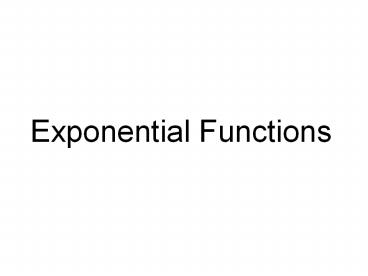Exponential Functions - PowerPoint PPT Presentation
1 / 10
Title:
Exponential Functions
Description:
Title: Thinking Mathematically by Robert Blitzer Author: jacci white Last modified by: Saint Leo Created Date: 3/2/2000 1:54:01 PM Document presentation format – PowerPoint PPT presentation
Number of Views:41
Avg rating:3.0/5.0
Title: Exponential Functions
1
Exponential Functions
2
Definition of the Exponential Function
Here are some examples of exponential
functions. f (x) 2x g(x) 10x h(x) 3x1
3
Text Example
The exponential function f (x) 13.49(0.967)x
1 describes the number of O-rings expected to
fail, f (x), when the temperature is xF. On the
morning the Challenger was launched, the
temperature was 31F, colder than any previous
experience. Find the number of O-rings expected
to fail at this temperature.
Solution Because the temperature was 31F,
substitute 31 for x and evaluate the function at
31.
4
Characteristics of Exponential Functions
- The domain of f (x) bx consists of all real
numbers. The range of f (x) bx consists of all
positive real numbers. - The graphs of all exponential functions pass
through the point (0, 1) because f (0) b0 1. - If b gt 1, f (x) bx has a graph that goes up to
the right and is an increasing function. - If 0 lt b lt 1, f (x) bx has a graph that goes
down to the right and is a decreasing function. - f (x) bx is a one-to-one function and has an
inverse that is a function. - The graph of f (x) bx approaches but does not
cross the x-axis. The x-axis is a horizontal
asymptote.
f (x) bx b gt 1
f (x) bx 0 lt b lt 1
5
Transformations Involving Exponential Functions
6
Text Example
Use the graph of f (x) 3x to obtain the graph
of g(x) 3 x1.
Solution Examine the table below. Note that the
function g(x) 3x1 has the general form g(x)
bxc, where c 1. Because c gt 0, we graph g(x)
3 x1 by shifting the graph of f (x) 3x one
unit to the left. We construct a table showing
some of the coordinates for f and g to build
their graphs.
7
The Natural Base e
An irrational number, symbolized by the letter e,
appears as the base in many applied exponential
functions. This irrational number is
approximately equal to 2.72. More accurately,
The number e is called the natural base. The
function f (x) ex is called the natural
exponential function.
-1
8
Formulas for Compound Interest
- After t years, the balance, A, in an account with
principal P and annual interest rate r (in
decimal form) is given by the following formulas - For n compoundings per year A
P(1 r/n)nt - For continuous compounding A Pert.
9
Example
- Use A Pert to solve the following problem Find
the accumulated value of an investment of 2000
for 8 years at an interest rate of 7 if the
money is compounded continuously - Solution
- A PertA 2000e(.07)(8)A 2000 e(.56)A
2000 1.75A 3500
10
Exponential Functions































